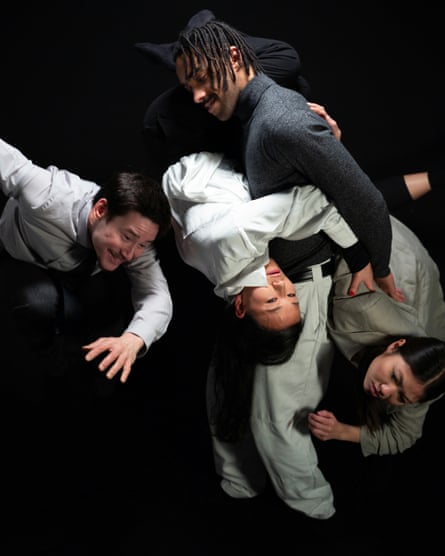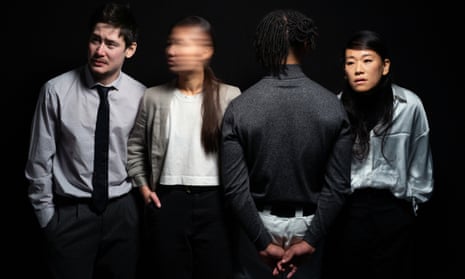A group of office workers are each hiding something about their lives in Si Rawlinson’s new stage show Saving Face. There’s the office manager struggling with the demands of her position; the man who has a strained relationship with his father and becomes his caregiver; a woman with OCD who desperately tries to hide her compulsions from colleagues.
Rawlinson, 36, has an autoimmune condition that means he is allergic to most food, and needs regular treatment. His experience of living with this chronic invisible illness inspired the character he plays. “Maybe he works well, sometimes he’s bad at his job, and I want it to be like, ‘Is he bad at his job because he’s ill? Or is he just bad at his job?’” explains Rawlinson. “How much do you make yourself accountable for the things in your life? How much is the result of the situation you’ve been put in?”
The British Chinese actor and theatre-maker has wrestled with these questions about his own illness. He wants the audience to consider how they relate to the character – whether they feel empathy for him and if it is OK to criticise him. “And to understand that there’s nuance there,” he adds. The workplace is an ideal setting to explore our need to present a version of ourselves without showing fragility, he says, and to consider “how that’s tied into our self-value, and our fear of being somehow destroyed if those things are made visible, or admitted to”.

The set is an important part of demonstrating the characters’ relationship to work. There are four workspaces and each is mobile, which is key to Rawlinson’s choreography. “There will be times when someone might be trying to get out of the office, and then it will kind of stalk them – it’s the idea that we can’t leave the office behind,” explains Rawlinson.
Saving Face mixes hip-hop and contemporary dance with physical theatre. There is dialogue, too, but at moments of conflict and tension the performers break into pure movement. For Rawlinson, dance is a way of having agency over his body. Growing up in Hong Kong, then moving to the UK aged seven, he had a childhood affected by illness. “I felt very much that the universe was forcing me into a position where I couldn’t do things,” he says. “And then I saw dance. At the University of Leeds I saw, through a doorway, people doing breaking. And I was like, that’s what I want to do. There was definitely a feeling of a ‘fuck you’ to the universe. I’m going to do this. Whatever is going on with my health, I have this feeling like I’ve got some control.”
Since discovering dance, his shows – typically exploring compassion, identity and our relationship with a changing world – have been performed at venues including the Place and Sadler’s Wells in London and at Birmingham Hippodrome. He is one of three associate artistic directors at the arts organisation Kakilang (formerly Chinese Arts Now), which produces and presents multidisciplinary artforms from south-east and east Asian voices. Rawlinson’s work is often autobiographical but for Saving Face, produced by Kakilang, the subject also “needs a bit of space from myself” which led him to creating fiction threaded with lived experience.
Rawlinson wants to avoid “trauma porn” around illness – “where you just show how difficult it is. I don’t know if it serves a story other than just making people feel like, ‘Oh, well that seems bad.’ The story is really about people and how they relate to each other, with humour a key part of the performance too as “it allows us to process difficult stories,” Rawlinson says.
You may care about his characters and want to know what happens to them, he says of Saving Face. “Or maybe you dislike them, but you’re invested in them and you see yourself in different parts of them.” Either way, he hopes the performance will stay with audiences – and that they will “go home and reflect on and think about how we might see the world differently”.
Saving Face is at Curve, Leicester, 26-27 May, and the Place, London, 23-24 June
